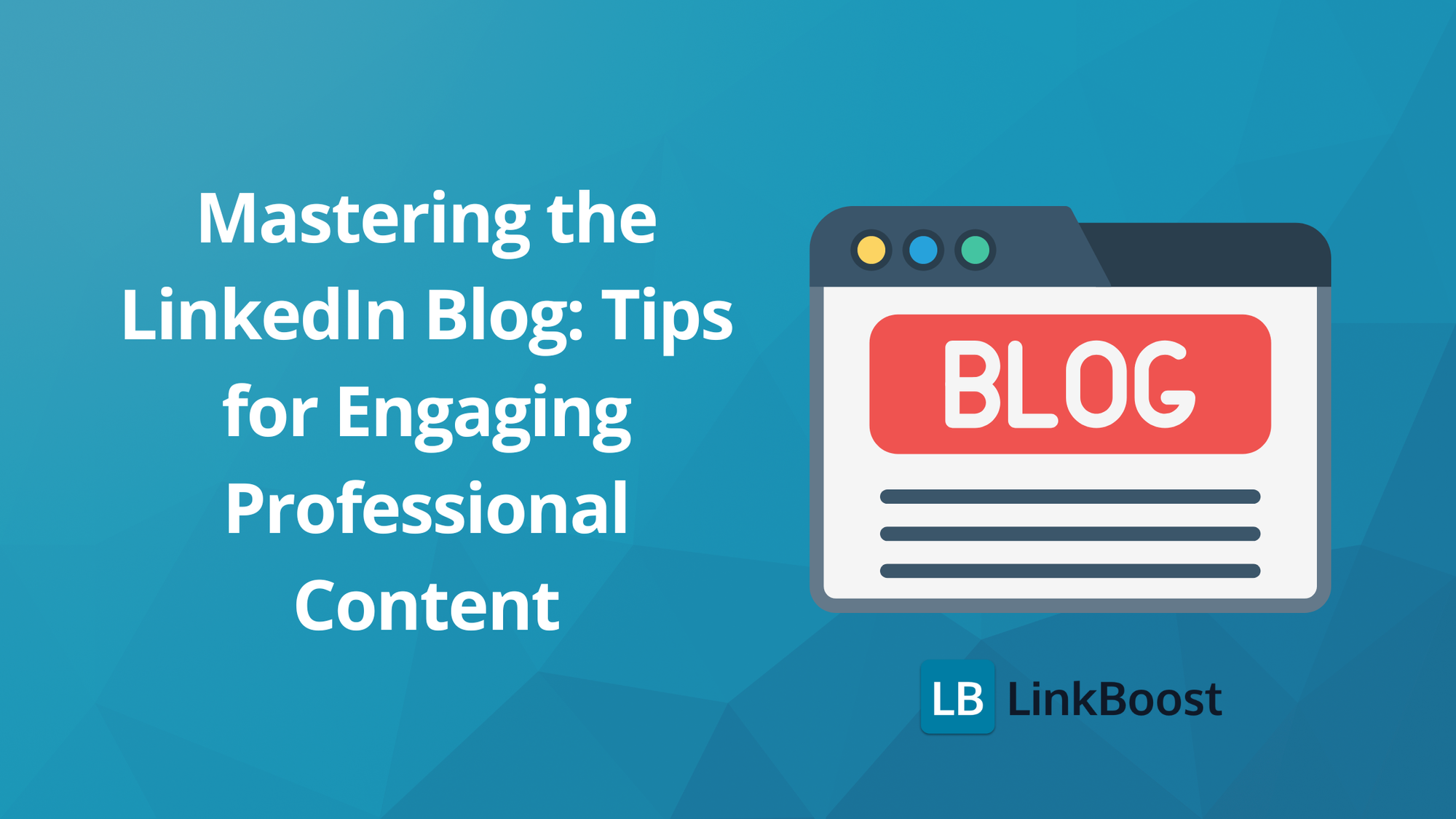Mastering the LinkedIn Blog: Tips for Engaging Professional Content

Looking to make an impact with a LinkedIn blog? This guide will show you how to start blogging on LinkedIn, the benefits it offers, and key strategies for creating engaging content.
Key Takeaways
- Blogging on LinkedIn provides immediate visibility to a built-in audience, enhancing professional networking and establishing authority without additional promotion.
- Craft compelling headlines and create engaging content by focusing on your audience’s needs and incorporating visuals, which boosts engagement and retention.
- Optimize your LinkedIn blog by maintaining consistency, utilizing effective hashtags, and leveraging analytics to refine your content strategy based on audience interactions.
Why Blogging on LinkedIn Matters

LinkedIn has evolved from a simple networking platform to a dynamic venue where professionals can share their thoughts and expertise through LinkedIn blogs. This transformation is significant because it provides a built-in audience eager to engage with insightful content without requiring additional promotional efforts. Imagine publishing a blog post and having it immediately visible to a network of professionals who are already interested in your industry—this is the power of LinkedIn.
The platform’s algorithm further enhances this visibility by promoting posts among users’ networks, ensuring that your content reaches a wide array of potential readers. This means that when you start blogging on LinkedIn, you’re not just sharing your knowledge; you’re also increasing your chances of connecting with people who can impact your career. Additionally, LinkedIn fosters a community that actively participates in discussions, helping shape industry trends and providing a space for meaningful exchanges.
Moreover, LinkedIn blogging allows professionals to showcase their expertise and insights, thereby building their reputation in their respective fields. Consistently publish articles that are well-thought-out blog article helps you gain exposure, establish authority, and connect with a network of professionals who value your input.
In essence, LinkedIn blogging is not just about sharing content; it’s about creating a professional persona that stands out in your industry.
How to Start Blogging on LinkedIn
Starting a blog on LinkedIn is a straightforward process, thanks to its user-friendly content publishing platform, LinkedIn Pulse. Your journey begins with a well-crafted LinkedIn profile that serves as your digital introduction. From there, you can access the blog editor by navigating to your feed and clicking on ‘Write an article’ or by pressing the pencil icon in your post status update box.
Before diving in, it’s crucial to find your focus and define your niche, ensuring that your content resonates with your target audience. The LinkedIn blog editor offers various features, including formatting options, and the ability to add images, videos, slides, links, and code snippets.
Crafting Compelling Headlines
Headlines are the first impression of your blog and play a critical role in grabbing attention and encouraging readers to continue. An effective headline should evoke curiosity, convey urgency, and offer clear value, compelling readers to click and read further. For example, a headline like “5 Essential Skills Every Marketing Professional Needs” is more likely to draw in readers than a generic “Marketing Skills.” Incorporating engaging images alongside your headlines can significantly amplify their impact, making your LinkedIn articles stand out in a crowded feed.
Consider your target audience and the value your article provides them. A great headline should not only attract but also set the right expectations for the content that follows, including any published articles.
Think of it as a promise to your readers that the time they invest in reading your blog post will be worth it. By crafting insightful and compelling headlines, you set the stage for a successful LinkedIn blogging experience.
Writing Engaging Content
Writing engaging content marketing is about understanding your target audience and tailoring your message to address their pain points and aspirations. Adopting a casual and conversational tone makes your writing more relatable and accessible. Sharing personal experiences, tips, and success stories can create a stronger connection with your readers, making your content more impactful. Encouraging readers to leave comments and responding quickly helps foster a community and enhances engagement.
Break down complex concepts into easily digestible parts, use short paragraphs, bullet points, and captivating visuals to make your content more engaging. Aim for a word count between 500 to 800 words to keep your readers’ attention. Focusing on a specific niche helps establish your authority and ensures that your content resonates with your audience. Lastly, choose topics you are passionate about to prevent content fatigue and enjoy the writing process.
Following relevant hashtags on LinkedIn is a great way to stay updated on trending topics and find inspiration for your new content. This approach not only helps in generating ideas but also in ensuring that your blog posts remain relevant and engaging to your audience.
Adding Images and Videos
Incorporating visuals such as images and videos can significantly enhance the engagement rates of your LinkedIn blogs. Visual elements make your content more appealing and can help clarify complex information. You can easily upload images from your computer or embed videos from platforms like YouTube to enrich your blog articles.
Adding these elements breaks the monotony of text and provides a richer reading experience that can keep your audience hooked. It’s a great idea.
Optimizing Your LinkedIn Blog for Success

Optimizing your LinkedIn blog involves several strategies to ensure your blog posts perform well and reach the right audience. This includes creating effective headlines, sharing personal insights, and maintaining a regular posting schedule. Enhancing your personal branding and regularly updating your LinkedIn blog can improve your search engine ranking and help you engage with your audience more effectively.
LinkedIn’s large user base offers immediate visibility for your content without the need to manage website hosting or technical issues. Here are some specific search engine optimisation techniques:
Utilizing Hashtags Effectively
Hashtags play an essential role in sharing content on LinkedIn, as they help curate content and increase its visibility. Maximize your reach by researching and using a mix of both popular and niche hashtags. While popular hashtags can draw a broader audience, niche ones allow your content to stand out in specific communities.
Including multiple related tags in your blog article’s description can also enhance its reach.
Sharing Posts Across Platforms
Utilizing various social media platforms to share your LinkedIn blog posts can significantly enhance visibility and engagement. Cross-promotion on platforms like Twitter and Facebook can substantially increase the reach of your content. If your LinkedIn profile is set to public, you can share your posts elsewhere, making them accessible to a broader audience. Additionally, promoting your LinkedIn articles by sharing links in social media groups and your email signature can drive more traffic to your posts.
Incorporate images and videos in your LinkedIn posts to boost viewer engagement and clarify your message. These visual elements can make your content more appealing and shareable, further extending its reach across different platforms.
Effectively utilizing cross-platform sharing ensures that your LinkedIn blogs get the attention they deserve.
Consistency is Key
Maintaining a regular posting schedule is crucial for keeping your audience engaged and setting clear expectations. By consistently updating your LinkedIn blog, you establish a reliable presence that encourages follower loyalty. A predictable posting rhythm helps build a loyal audience that regularly engages with your content. However, it’s important not to prioritize volume over quality; high-quality posts are more likely to engage readers and encourage interaction.
Neglecting community engagement can result in a lack of loyal readers; fostering a community encourages interaction and feedback, which are essential for a thriving blog. Regularly interacting with your readers and responding to their comments can help build a strong, loyal community around your content.
LinkedIn Blog vs. Traditional Blogging Platforms

Blogging on LinkedIn offers the unique advantage of a built-in audience for immediate visibility, thanks to its large user base and algorithm that boosts articles. This means your blog posts can quickly reach a wide array of professionals without extra promotional efforts. However, traditional blogging platforms like WordPress provide greater control over content and audience engagement. On personal blogs, you can collect visitor email addresses, build a subscriber list, and have complete control over the user experience.
LinkedIn articles and blog posts serve distinct purposes and can sometimes confuse users, but they can complement each other effectively. For instance, using LinkedIn to drive traffic back to your personal blog can help maintain a streamlined editing process while reaching a broader audience. The LinkedIn format, however, may distract readers with features that divert attention from the blog content.
Furthermore, tools like the WP LinkedIn Auto Publish plugin allow users to easily share WordPress posts on LinkedIn, creating a seamless integration between the two platforms. Leveraging both LinkedIn and traditional blogging platforms maximizes your reach and helps maintain a consistent content strategy, including your linkedin post.
Leveraging LinkedIn Analytics
LinkedIn analytics tools are invaluable for tracking key performance indicators (KPIs) for your blog articles. By navigating to the ‘Posts & Activity’ section of your profile, you can track impressions and engagement metrics, including reactions, comments, and reposts. These insights help you understand how your audience interacts with your content and which topics resonate the most.
Using analytics effectively allows you to refine your content strategy based on data-driven insights. You can filter audience insights by job title, industry, and company size, providing a deeper understanding of your readers. This information can guide your future blog posts, ensuring that you continue to deliver content that meets your audience’s needs and interests.
Common Mistakes to Avoid

Avoiding common mistakes is crucial for maintaining the effectiveness and professionalism of your LinkedIn blog. Using unreliable hosting services can negatively affect site performance, causing slow load times and visitor loss. Uploading large images without optimization can also slow down your site, impacting user experience and search ranking.
Additionally, skipping internal links can hinder reader navigation and reduce site engagement, making it harder for visitors to explore your content. Being aware of these pitfalls ensures a smoother and more engaging blogging experience.
Summary
In summary, LinkedIn has transformed into a powerful platform for professional blogging, offering immediate visibility and a built-in audience. By crafting compelling headlines, writing engaging content, and incorporating images and videos, you can create impactful blog posts that resonate with your readers. Optimizing your LinkedIn blog through effective use of hashtags, cross-platform sharing, and maintaining consistency ensures long-term success.
As you embark on your LinkedIn blogging journey, remember to leverage analytics to refine your strategy and avoid common mistakes that can hinder your progress. With these tips and insights, you are well-equipped to make the most of LinkedIn’s blogging capabilities and build a strong professional presence. Start blogging today and watch your influence grow in your industry.
Frequently Asked Questions
How do I start blogging on LinkedIn?
To start blogging on LinkedIn, just click on 'Write an article' or the pencil icon in your update box. Make sure your profile is polished and that you define your niche to connect with the right audience!
What makes a compelling headline for a LinkedIn blog post?
To create a compelling LinkedIn blog post headline, make sure it sparks curiosity, conveys urgency, and clearly states the value it offers. Pair it with engaging images to really boost its appeal!
How can I make my LinkedIn blog content more engaging?
To make your LinkedIn blog content more engaging, focus on understanding your audience and using a conversational tone. Share personal experiences and break down complex concepts with visuals and bullet points to draw readers in and encourage comments.
How can I optimize my LinkedIn blog for better visibility?
To boost your LinkedIn blog's visibility, mix popular and niche hashtags, share your posts on other social media, and post regularly. Don’t forget to check LinkedIn analytics to fine-tune your strategy!
What are common mistakes to avoid when blogging on LinkedIn?
To make your LinkedIn blog successful, steer clear of unreliable hosting, huge unoptimized images, and neglecting internal links. These common pitfalls can really hurt your site's performance and the reader's experience.

